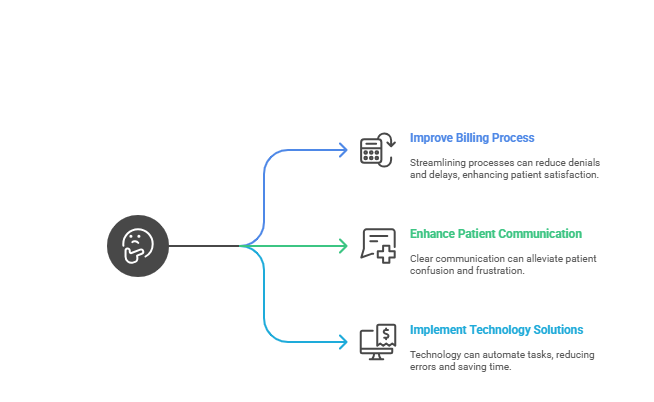On-Demand Outsourcing BPO Services for Healthcare Providers With 24/7 Coverage!
Save up to 70% on staffing costs!
Browse Specialty Staffing ServicesPrimary vs. Secondary Insurance: What Every Front Desk Team Should Know

When Lisa checked in for her appointment, she handed over two insurance cards. The front desk froze. Which one gets billed first? What happens if one denies?
By the time her eligibility was verified, the waiting room had backed up, and Lisa was frustrated.
The confusion? Understanding primary vs. secondary insurance—a critical piece of eligibility and billing that can make or break timely payments.
What Does “Primary” vs. “Secondary” Insurance Mean?
When a patient has more than one insurance plan, the primary insurance is billed first. The secondary insurance covers eligible remaining costs, like copays, coinsurance, or uncovered portions.
This process, called coordination of benefits (COB), ensures claims are processed in the correct order, preventing denials and reducing out-of-pocket costs for patients.
Why This Matters for Healthcare Support Teams
Getting primary and secondary insurance wrong can lead to:

Claim denials or delays
Increased patient balances
Time-consuming re-billing and appeals
Frustrated patients stuck in billing confusion
Support agents who understand this distinction keep both patients happy and revenue cycles clean.
How to Determine Primary vs. Secondary Insurance
Here’s how to figure it out:
Employment-Based Coverage First
If a patient is covered through their employer and also as a dependent (e.g., on a spouse’s plan), the employer’s plan is primary.Medicare + Other Insurance
When Medicare is involved:
If the patient is still actively employed and has employer coverage: Employer plan is primary.
If retired: Medicare is primary.
Children with Two Insured Parents
The “Birthday Rule” applies: the parent whose birthday falls first in the calendar year provides the primary insurance.Accidents and Liability Claims
Auto or workers’ comp coverage is primary for accident-related care, before health insurance pays.
Real Impact: Why It Matters to Get This Right
A multispecialty clinic in Texas saw a 30% reduction in claim denials after implementing a clear primary vs. secondary insurance verification workflow. Patients appreciated fewer surprise bills, and staff saved hours on rework.
Staffingly: Mastering Coordination of Benefits for You
At Staffingly, our insurance eligibility and verification specialists handle the complexity for you:
Identify primary vs. secondary coverage upfront
Coordinate COB rules based on payer guidelines
Prevent duplicate billing and denials
Communicate clearly with patients about their responsibility
With our help, you get faster payments, fewer disputes, and happier patients.
What Did We Learn?
Here’s the key takeaway: understanding primary vs. secondary insurance is crucial for clean claims, faster payments, and happier patients.
Primary insurance always pays first, while secondary insurance may cover remaining balances, depending on eligibility.
Coordination of Benefits (COB) rules determine which plan is billed first—based on factors like employment, Medicare status, and family coverage.
Mistakes in COB lead to denials, rework, delayed payments, and billing confusion for patients.
Verifying coverage and COB at every visit ensures accurate billing and prevents unnecessary disputes.
With Staffingly’s eligibility verification specialists, your team can confidently handle COB and avoid the common pitfalls that cost practices time and money.
What people are asking?
1.What is primary vs. secondary insurance in simple terms?
Primary insurance pays the claim first. Secondary insurance may cover what’s left, such as copays or coinsurance, depending on the plan.
2. Can a patient choose which plan is primary?
No. Coordination of Benefits (COB) rules set by insurers determine which plan is primary. Patients can’t change this order.
3. If a patient has Medicare and employer insurance, which is primary?
If the patient is actively employed (or covered by a working spouse’s plan), the employer plan is primary.
If retired, Medicare is primary.
4. How does primary vs. secondary insurance work for children?
The “Birthday Rule” applies: the plan of the parent whose birthday falls first in the calendar year is primary.
5. What happens if we bill the secondary insurance first?
The claim will be denied, and you’ll have to rebill the correct payer, delaying payment and creating more work for staff.
6 Does secondary insurance always cover what primary doesn’t?
Not always. It depends on the secondary plan’s rules, allowed amounts, and coordination with the primary plan.
Disclaimer
For informational purposes only; not applicable to specific situations.
For tailored support and professional services,
Please contact Staffingly, Inc. at (800) 489-5877
Email : support@staffingly.com.
About This Blog : This Blog is brought to you by Staffingly, Inc., a trusted name in healthcare outsourcing. The team of skilled healthcare specialists and content creators is dedicated to improving the quality and efficiency of healthcare services. The team passionate about sharing knowledge through insightful articles, blogs, and other educational resources.
 Book a Demo to Build Your Team Today!
Book a Demo to Build Your Team Today!

 Read Case Studies
Read Case Studies 


 Virtual Medical Assistants
Virtual Medical Assistants



